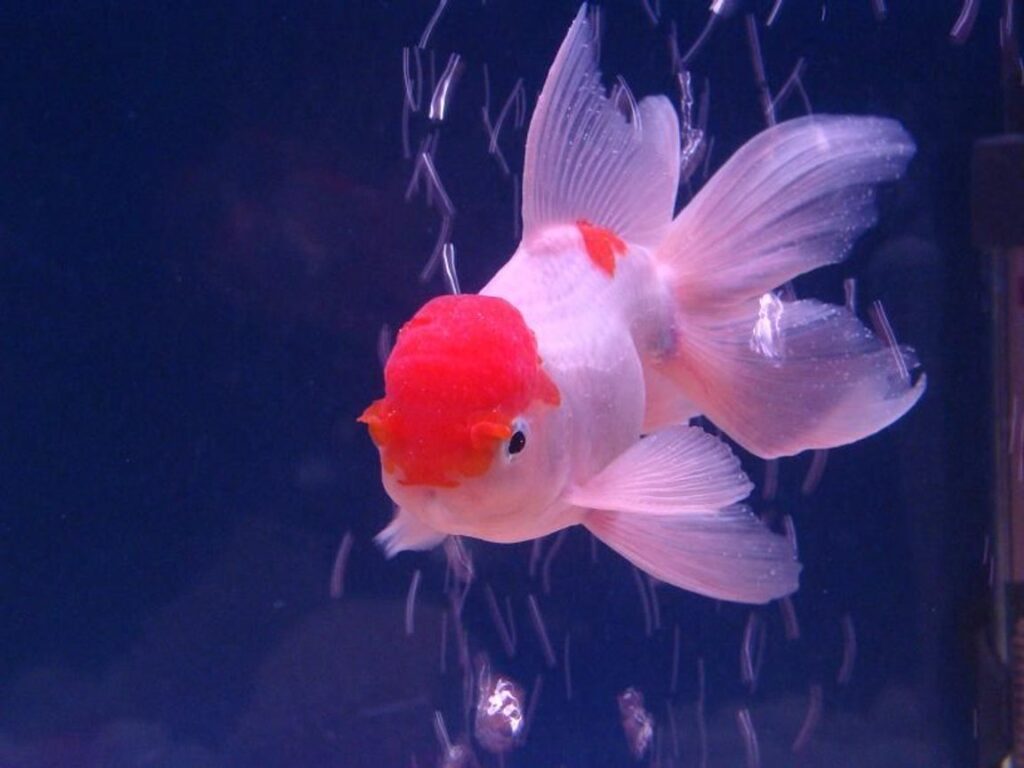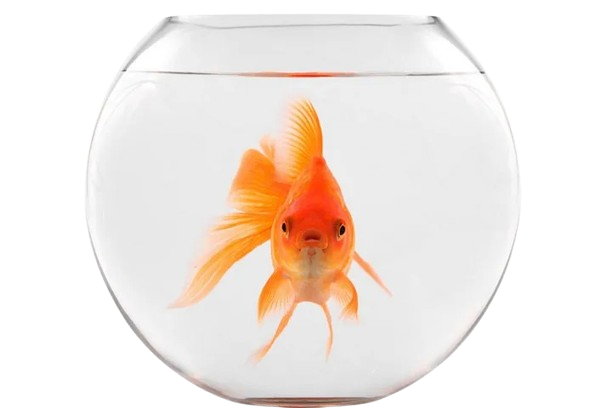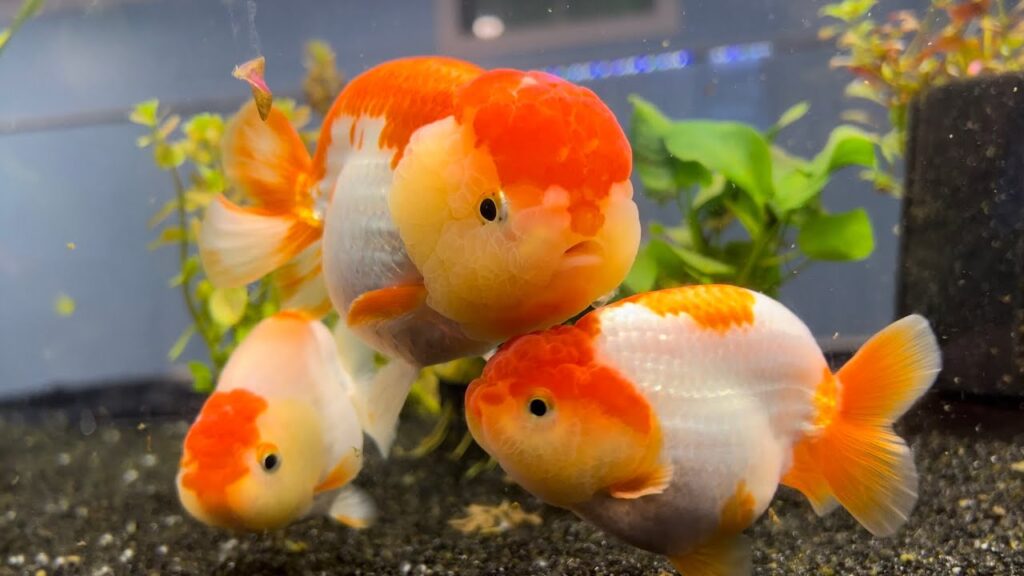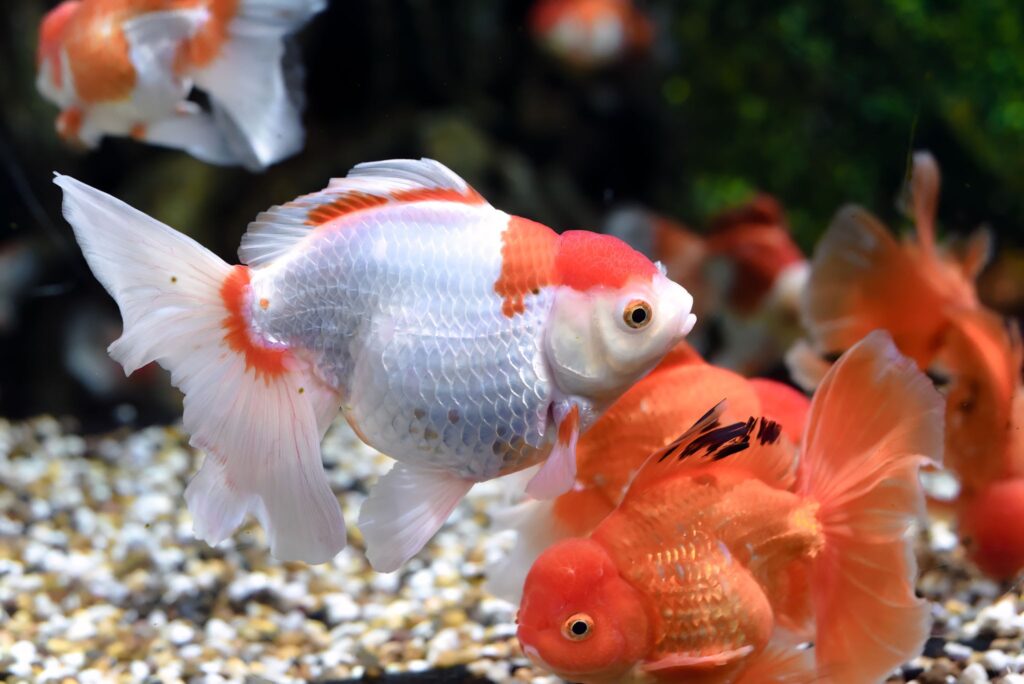The Redcap Oranda Goldfish is a beautiful fish. They have bright red “caps” on their heads and beautiful flowing fans. They add beauty to any aquarium with their graceful movements and peaceful nature. They get along well with other fish and are fun to watch as they explore their surroundings and interact with each other. Overall, they are beautiful pets that bring beauty and charm to any aquarium.
Table of Contents
Origin and History Of Red Cap Oranda Goldfish
Redcap Orenda goldfish are found mostly in China and Japan, where they have been domesticated for centuries. The Red Cap Orenda Goldfish came from the regular goldfish, but people have chosen them with special features like the big red spot on their head. This careful breeding made them different from other goldfish.
People started breeding goldfish a long time ago, even in ancient China around 618-907 AD. They chose specific goldfish for their colors and the shape of their fins. As time went on, during the Song Dynasty (960-1279 AD), they began to develop different types of goldfish, such as oranda, which had special growths on their heads.
In Japan, goldfish breeding also has a rich history, with selective breeding methods dating back to the Edo period (1603-1868). The Japanese played an important role in improving the Oranda variety, emphasizing characteristics such as the red cap and the overall balance and balance of the fish.
Red cape orandas gained popularity in the Western world in the late 19th and early 20th centuries, as trade routes expanded and exotic fish became more accessible. They were prized for their striking appearance and gentle disposition, soon becoming a sought-after addition to decorative ponds and indoor aquariums alike.
Today the redcap oranda goldfish is a favorite among fish enthusiasts worldwide. They are bred for various color variations and characteristics, ensuring their enduring popularity in the world of aquaculture and ornamental fish care.
Physical Characteristics Of Red Cap Oranda Goldfish
The Redcap Orenda Goldfish stands out because of its characteristics. They have a round body and a large, round head with a prominent red spot on top, called a “cap”. Their fins are long and flowing, giving them a graceful appearance while swimming. These fish come in a variety of colors, but the red caps on their heads make them stand out.
The life span of Red Cap Oranda Goldfish
Redcap Oranda Goldfish can live a long time if they are properly cared for. Generally, they can last for about 10 to 15 years, sometimes even longer. Just like any pet, their lifespan can vary depending on things like how well they are cared for and the environment they live in. So, with some love and good care, you can enjoy their company for many years.
Typical Size
Redcap oranda goldfish are usually about 6 to 8 inches long, although some can grow larger, 10 inches or more, depending on genetics, diet, and the size of their habitat.
Caring for Red Cap Oranda Goldfish
Caring for a redcap oranda goldfish is fairly straightforward. First, make sure they have a clean tank with plenty of room to swim. Keep the water clean by doing regular partial water changes. They like moderate temperatures, around 65-75°F (18-24°C).
Feed them a balanced diet of high-quality fish food, and don’t overfeed them. They are omnivores, so they will eat both plant and animal based foods. Watch for signs of illness or trouble, such as changes in behavior or appetite, and address any problems immediately.
Finally, provide them with places to hide and explore in their tank, such as plants or decorations. With a little attention to their needs, your redcap oranda goldfish can thrive and bring joy to your aquarium for many years.
Required Tank Size for Red Cap Oranda Goldfish
To keep redcap oranda goldfish happy and healthy, you’ll need a tank that gives them enough room to swim around comfortably. In general, a minimum tank size of 20 gallons (about 75 liters) is recommended for a redcap oranda. However, if you plan to keep multiple goldfish or add other fish species to the tank, you will need a larger tank to accommodate their needs.
Goldfish produce more waste than some other fish species, so having a large tank with a good filtration system helps maintain water quality. This can prevent health problems and keep your fish thriving. Providing enough space also allows for natural behaviors such as swimming and exploring, which contributes to their overall well-being.
Remember, tank size is only one aspect of proper goldfish care. Regular water changes, proper filtration, and monitoring of water parameters are also important to create a healthy environment for your redcap oranda goldfish.
Optimal Water Parameters
Maintaining optimal water parameters is critical to the health and well-being of Redcap Oranda Goldfish. Here are the recommended water parameters:
1- Temperature: Keep the water temperature between 65-75°F (18-24°C). Avoid extreme fluctuations in temperature, as this can stress the fish.
2- pH Level: Aim for a pH level between 7.0 and 7.4, which is neutral to slightly alkaline. Goldfish can tolerate a slightly wider pH range, but consistency is important.
3- Ammonia and nitrite levels: Keep ammonia and nitrite levels at 0 ppm (parts per million). These compounds are toxic to fish and can harm their health. Regular water testing and proper filtration are essential to prevent ammonia and nitrate build-up.
4- Nitrate Level: Nitrate levels should be kept below 40 ppm. Although nitrites are less harmful than ammonia and nitrites, high levels can still stress fish and compromise their health. Regular water changes can help keep nitrate levels under control.
5- Water Hardness: Goldfish adapt to a wide range of water hardness levels. Aim for a general hardness (GH) of 100-250 ppm and a carbonate hardness (KH) of 50-150 ppm.
Maintaining stable water parameters is critical, so be sure to monitor them regularly using a reliable water testing kit. Additionally, do routine water changes (about 10-25% of tank volume) every 1-2 weeks to remove accumulated waste and replenish essential minerals. With proper care and attention to water quality, your redcap oranda goldfish can thrive in their aquarium environment.
Setting up the Tank for Red Cap Oranda Goldfish
The Red Cap Oranda goldfish tank installation uses solar energy to create a comfortable and healthy environment for your fish. Here is the Basic Guide:
- Tank Size: Choose a tank that gives your goldfish plenty of room to swim and grow. A minimum tank size of 20 gallons (75 liters) is recommended for one fish, but larger tanks are better for multiple fish.
- Substrate: It has a fine gravel substrate and a smooth aquarium sand line, with a tank underneath. Cold sores wear your goldfish under the wood.
- Filtration: Invest in a quality filtration system that can handle the waste produced by goldfish. Consider a hang-on back or canister filter with a strong flow rate to keep the water clear and clean.
- Decorations: Add decorations such as plants, rocks and driftwood to provide your goldfish with hiding places and enrichment. Just make sure any decorations are smooth and will not harm your fish.
- Water Conditioner: Treat tap water with a water conditioner to remove chlorine, chloramines and heavy metals that can harm your fish. Follow the dosage instructions on the conditioner label.
- Cycling the Tank: Before adding fish, cycle the tank to establish beneficial bacteria that will break down waste products. This usually takes 4-6 weeks and involves adding an ammonia source (such as fish food or ammonia solution) and monitoring water parameters.
- Temperature and Water Parameters: Install a thermometer to monitor the water temperature and, if necessary, adjust the heater to maintain a temperature between 65-75°F (18-24°C). Ensure that water parameters such as pH, ammonia, nitrite, and nitrite levels are within the recommended range for your Red Cap Oranda goldfish.
- Acclimating Your Fish: When it’s time to add your redcap oranda goldfish to the tank, introduce them slowly to avoid stress. Float the bag containing the fish in the tank for 15-20 minutes to equalize the water temperature, then slowly add tank water to the bag over 30-60 minutes before releasing the fish into the tank.
By following these steps, you can create a comfortable and healthy habitat for your redcap oranda goldfish to thrive. Regular maintenance, including water testing, partial water changes, and filter maintenance, will help ensure the continued health and happiness of your fish.
Common Diseases in Red Cap Oranda Goldfish
Redcap oranda goldfish are generally hardy, but like all fish, they can be susceptible to certain diseases. Here are some common ailments to watch out for:
- Ich (White Spot Disease): Ichthyophthirius multifiliis, or Ich, is a parasitic infection characterized by small white spots on the body and fins of fish. It can cause itching and irritation and, if left untreated, can lead to secondary infection or death.
- Fin Rot: Fin rot is a bacterial infection that causes the fins to become dull, cracked, or discolored. This is often caused by poor water quality, stress, or injury. If not treated promptly, fin rot can progress rapidly.
- Swim Bladder Disorder: A swim bladder disorder affects the growth of the fish, causing them to float to the surface or sink uncontrollably. This condition can be caused by overeating, constipation, or bacterial infection.
- Dropsy: Dropsy is a symptom rather than a specific disease, characterized by swelling or swelling of the fish’s body. It is often associated with internal bacterial infection or kidney failure and may be accompanied by pineconing of the scales.
- Mouth Rot: Mouth rot, also known as mouth fungus or cottonmouth, is a bacterial infection that affects the mouth of fish, causing white or gray patches, inflammation and difficulty eating. Poor water quality and stress can contribute to the development of oral cavity.
- Velvet Disease: Velvet disease, is caused by the parasite Piscinoodinium sp. Caused, appears as a yellow or gray film on the skin of the fish, resembling velvet or gold dust. Infected fish may exhibit rapid breathing, glowing behavior, and loss of appetite.
Disease prevention in redcap oranda goldfish involves maintaining optimal water quality, providing a balanced diet, and minimizing stressors such as overcrowding or sudden changes in water parameters. Quarantine new fish before introducing them to the main tank can also help prevent the spread of disease. If you notice any signs of illness in your goldfish, it is important to take immediate action by isolating the affected fish, treating the tank with appropriate medication, and consulting a veterinarian if necessary. Regular observation and preventive care are the keys to keeping your goldfish healthy and disease-free.
Feeding Habits of Red Cap Oranda Goldfish
Redcap oranda goldfish are omnivores, meaning they eat both plants and animals. Here is what you need to know about their eating habits:
- Diet: Offer a varied diet to ensure they get all the nutrients they need. This can include high-quality commercial fish flakes or pellets specially formulated for goldfish. Add fresh or blanched vegetables such as peas, zucchini, or lettuce to their diet as well as small amounts of live or frozen foods such as bloodworms, brine shrimp, or daphnia.
- Feeding Frequency: Feed your redcap oranda goldfish in small amounts 2-3 times a day. Avoid overfeeding, as this can cause digestive problems and water quality problems.
- Monitor Eating Behavior: Pay attention to how much your goldfish eats during each feeding session. Remove any uneaten food after a few minutes to prevent spoilage and contamination of the water.
- Seasonal Considerations: Adjust their diet based on seasonal changes. During the colder months, goldfish may have a slower metabolism and require less food. Conversely, in warmer months or during the breeding season, they may need more food to support their increased activity.
- Special Treats: Occasionally offer treats such as freeze-dried or live food to add variety to their diet and stimulate natural foraging behavior.
- Considerations for Young Fish: If you have juvenile redcap oranda goldfish, feed them small, frequent meals to promote rapid growth and development.
By providing a balanced diet and observing their eating behavior, you can ensure that your redcap oranda goldfish stays healthy, vibrant and active.
Behavior and Temperament
The attitude and temperament of the Redcap Oranda Goldfish is usually calm and peaceful. They are sociable fish that often interact with their tank mates and enjoy exploring their environment. Redcap orandas are not aggressive and can live peacefully with other fish species. They may occasionally display playful behaviors, such as chasing each other or teasing things in the tank. However, they are also sensitive to their environment and can become stressed by sudden changes in water conditions or disruptions to their environment. Overall, the Redcap Oranda Goldfish is a gentle and friendly fish that makes a pleasant addition to the community aquarium.
Suitable Tankmates of Red Cap Oranda Goldfish
The redcap oranda goldfish is generally peaceful and can live with a variety of tankmates. When choosing a tank mate for redcap orandas, it is important to consider fish species that share water parameter requirements and temperaments. Some suitable tank mates for redcap oranda goldfish are:
- Other Goldfish Varieties: Redcap Oranda can be kept with other types of goldfish, such as common goldfish, Fantails Gold Fish, Ryukins Gold Fish and Black Moor Gold Fish. Just make sure the tank is big enough to accommodate the extra fish comfortably.
- White Cloud Mountain Minnows: These small, peaceful fish are compatible with goldfish and can add activity to the bottom of the tank.
- Rosy Barbs: Rosy barbs are active, schooling fish that can tolerate the same water conditions as goldfish. They add color and movement to the aquarium.
- Weather Loaches: These bottom-dwelling fish are hardy and can thrive in the same tank as goldfish. They help keep the substrate clean by scavenging for food.
- Bristlenose Plecos: Bristlenose Plecos are algae-eating catfish that can help keep the tank clean. They are peaceful and compatible with goldfish.
- Snails: Snails such as nerite or mystery snails can be beneficial additions to a goldfish tank, as they help control algae growth and are generally peaceful.
When introducing tankmates to a redcap oranda goldfish tank, monitor their interactions closely to ensure compatibility. Avoid aggressive or fin-shaking species that may disturb the goldfish. Additionally, consider tank size and provide enough hiding places and visual barriers to reduce tension and territorial disputes between tank mates.
Breeding Information
Breeding Redcap Oranda Goldfish can be a rewarding but challenging endeavor. Here is some basic information about breeding these fish:
- Sexual Differentiation: Redcap oranda goldfish reach sexual maturity at about 1-2 years of age. Males generally have smaller, more streamlined bodies and may develop small white breeding tubercles (bumps) on their gill cover and pectoral fins during the breeding season. Females are full, especially when they are ovulating.
- Breeding Season: Redcap orandas, like other goldfish species, are stimulated to breed by changes in water temperature and daylight hours. They usually grow in the spring and summer months when temperatures rise and days are longer.
- Spawning Behavior: During the breeding season, males may chase females around the tank, push them, and display courtship behavior. When a female is ready to spawn, she releases her eggs while the male fertilizes the eggs externally by releasing sperm (mullet).
- Egg Care: After spawning, adult goldfish must be removed from the breeding tank to prevent them from eating the eggs. Redcap orenda eggs are sticky and stick to surfaces such as plants, rocks or tank walls. Provide aeration to ensure good water circulation around the eggs and prevent mold growth.
- Hatching and Fry Care: Redcap oranda eggs usually hatch in 4-7 days depending on water temperature. After hatching, fry will initially feed on their yolk sacs before transitioning to live foods such as infusoria or commercially available fry food. Maintain excellent water quality and perform regular water changes to ensure fry health and growth.
- Rearing Tank: Transfer the fry to a separate rearing tank equipped with a sponge filter for gentle filtration and to prevent the fry from being sucked into the filter. As the fry grow, gradually introduce larger food particles and monitor their growth closely.
Breeding redcap oranda goldfish requires careful planning, attention to water quality, and dedication to egg and fry care. It is important to have a proper breeding setup and be prepared to provide the necessary care for the offspring. Additionally, consider the genetic characteristics of the parent fish to produce healthy and desirable offspring.
Conclusion
In summary, the Redcap Orenda Goldfish is a beautiful and attractive fish that many people enjoy keeping in their aquariums. They are brightly colored and have a unique red spot on their head. Caring for them means making sure they have a good tank to live in and giving them the right food. They are friendly and can live comfortably with other fish. Whether you are new to fishkeeping or have been doing it for a while, having a redcap oranda goldfish can bring joy and peace to your home.
You can read more about on Wikipedia;
Related: Goldfish Oranda




